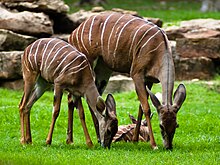Little kudu
| Little kudu | ||||||||||||
|---|---|---|---|---|---|---|---|---|---|---|---|---|

Male lesser kudu |
||||||||||||
| Systematics | ||||||||||||
|
||||||||||||
| Scientific name | ||||||||||||
| Ammelaphus imberbis | ||||||||||||
| ( Blyth , 1869) |
The lesser kudu ( Ammelaphus imberbis ) is an African antelope and the counterpart to the better-known greater kudu .
External features
The males of the lesser kudu can weigh up to 100 kilograms and have a shoulder height of up to one meter. The females are slightly smaller and can weigh up to 62 kilograms. There is a noticeable sexual dimorphism: only the males have screw horns up to 89 centimeters long.
The animals have a gray-brown coat that is covered with up to 15 narrow, white horizontal stripes on the body from the shoulders to the base of the tail. There are two distinct white spots on the neck. The legs are brown with a slight shade of orange.
Ruminating kudu usually stand in the shade of a tree with the back facing the tree. Due to their striped coat, their body outlines dissolve so that they are less visible to a predator. On the run, the little kudu shows the white underside of the tail, this so-called mirror probably serves as a signal to the conspecifics.
distribution
In contrast to the greater kudu , which is widespread across Africa, the lesser kudu has a relatively small distribution area that includes parts of Tanzania , Kenya , Ethiopia and Somalia . In 1967, surprisingly, a lesser kudu was discovered in a completely different place, namely in Yemen on the Arabian Peninsula . Since then there have also been indications of the occurrence of these animals in Saudi Arabia . However, they appear to be extremely rare or extinct there. Whether lesser kudu occurred naturally in Arabia or whether it was originally introduced there can no longer be traced.
The IUCN regards the lesser kudu as "dependent on protective measures".
habitat

The lesser kudu inhabits acacia forests and dense undergrowth. He is true to location. The females live in groups of around four to ten animals. Young males also form associations. Adult males, on the other hand, are loners who only team up with females during the mating season. The animals are mostly nocturnal, but can also be seen in the cooler times of the day.
The spatial behavior of the lesser kudu has mainly been studied in the Tsavo East National Park. The adult males roamed here through an area averaging around two square kilometers each. The individual territories overlapped with those of other males. Territorial demarcation behavior, for example through fights with other males, was not observed, nor was a ranking among the adult males recognizable. Subadult males roamed a larger area.
nutrition
Leaves are preferred as food , but grasses are not spurned either.
The feeding behavior of the lesser kudu has been investigated in the Tsavo East National Park , among other places , and it has been found that there is food competition primarily with the giraffe gazelle. However, the lesser kudu mainly lives in the savannah regions, which are denser with trees and shrubs. Because of the ability to stand on its hind legs while foraging for food, the giraffe gazelle can reach leaves that are inaccessible to the lesser kudu.
literature
- CA Spinage: The Natural History of Antelopes . Croom Helm, London 1986, ISBN 0-7099-4441-1
Web links
- Tragelaphus imberbis in the endangered Red List species the IUCN 2006. Posted by: Antelope Specialist Group, 1996. Retrieved on 11 May, 2006.

